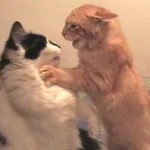Most first novels contain a protagonist with at least a little of the author in them. We’re told to write what we know, right? As you gain experience, you’ll want to work toward creating characters who are distinct and likable and who aren’t you.
Writing Tip for Today: How can a novelist create authentic characters who are separate from the author?
- Start with Composites. By combining the qualities of real-life people, you can avoid a reader recognizing him or herself or you in the pages of your novel. Take a personality, mix it with opposite sex, looks or other identifiers, and you’ve got a unique character.
- Scrutinize Dialogue. Read over your dialogue to be sure all the characters don’t sound alike. Give each a different way of not only speaking but thinking. You should know what Character A would or wouldn’t do in a situation even if that situation doesn’t occur in your story. A good way to do this is to “journal” the characters separately. Get past the looks, age or education and go for attitudes, hurts, wants and motives.
- Use Character Tags Wisely. You’ve heard of the technique of using a character tag (some particular thing a character does a lot of the time–raking fingers through hair, jingling change, saying “ain’t.”) But be careful. Readers will tire of the tag being shoved at them too often. And a tag that is only tacked on won’t be as impressive as one which arises naturally from the character’s emotions and motivations.
- No Lines, No Name. You may have a wonderful talent for creating characters with odd or memorable names. This is good, but if you have too many named characters, your reader will have trouble remembering who is who. I usually go by the rule that if a character has no speaking part, that character gets no name. Store clerks, policemen and other necessary but incidental characters can be just that.
- Dig Deeper. As you draft your novel, you may begin to see the character changing, not only in tone, but grower more three-dimensional. You discover hidden motivations, attitudes, prejudices you weren’t aware of at first. That’s great, but check to be sure your character isn’t grinding an axe you’ve wanted for years to grind yourself. Allowing revenge, bitterness or hatred into your character will not make the character sympathetic. And be prepared for a good bit of rewriting to smooth out those differences so readers will believe the character throughout.





Great post Linda. I especially like the advice to THINK like they think. On a funny side, I was recently asked if there was an autobiographical connection to my book MY MOTHER THE MAN EATER (about a forty something cougar). My response? Absolutely not!!! while writing what you know is good advice, sometimes we must step outside the box! 🙂
http://www.tracykraussexpressionexpress.com
I watched a lot of classic movies as a young person (and still do) and I think I learned so much about characters from that. I have always liked getting into the minds of other people. These points put it all in perspective. There is more to just dreaming up a character, you have to apply them to the words on the page.